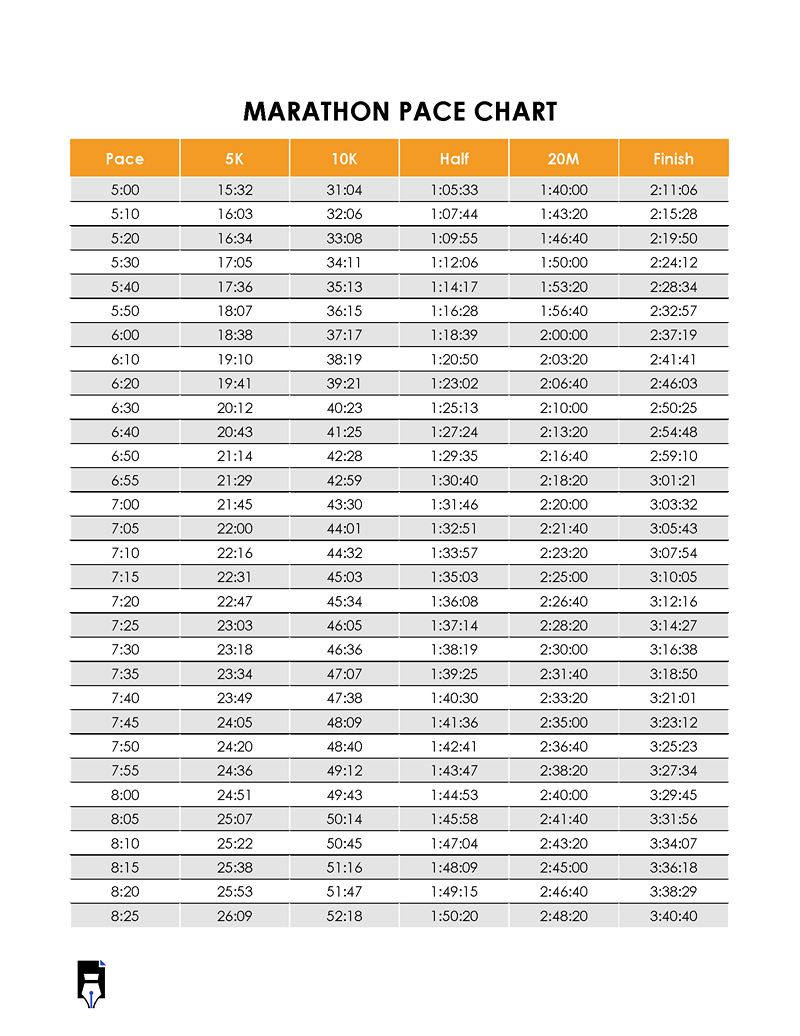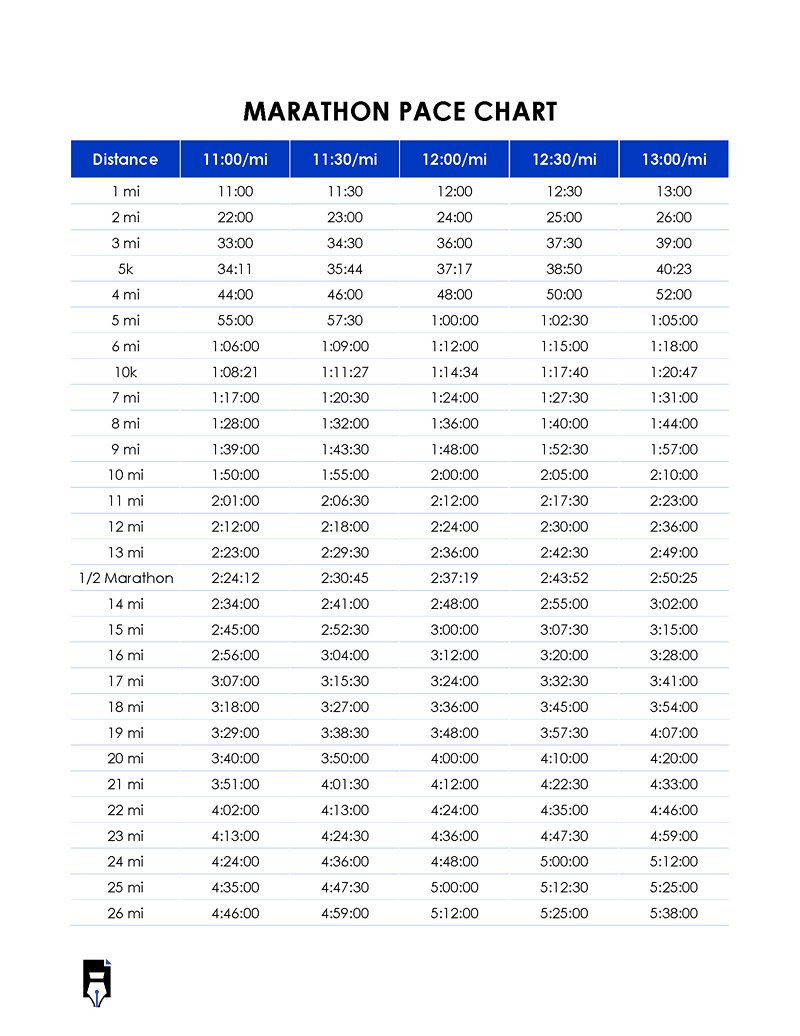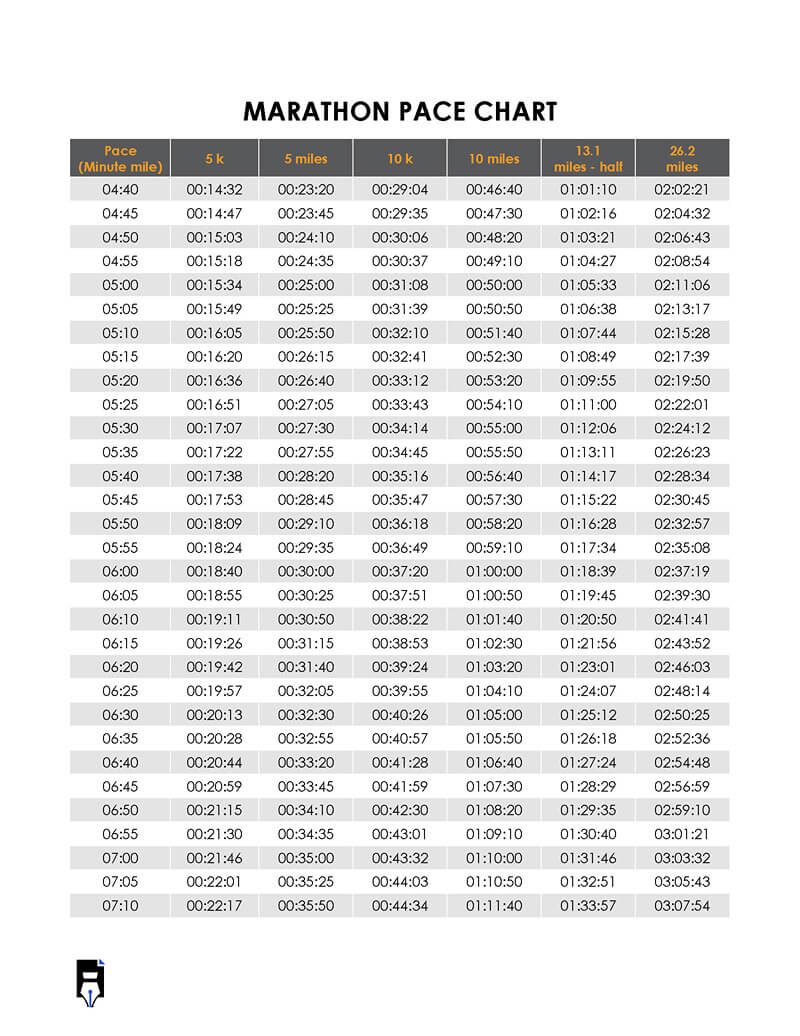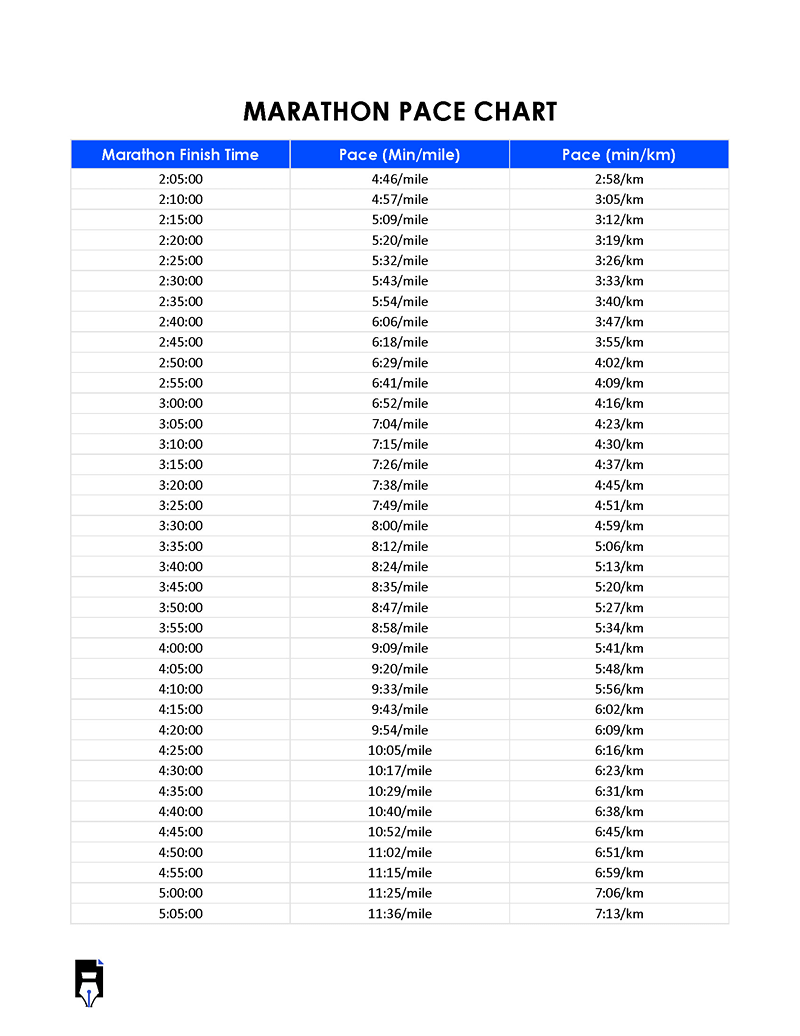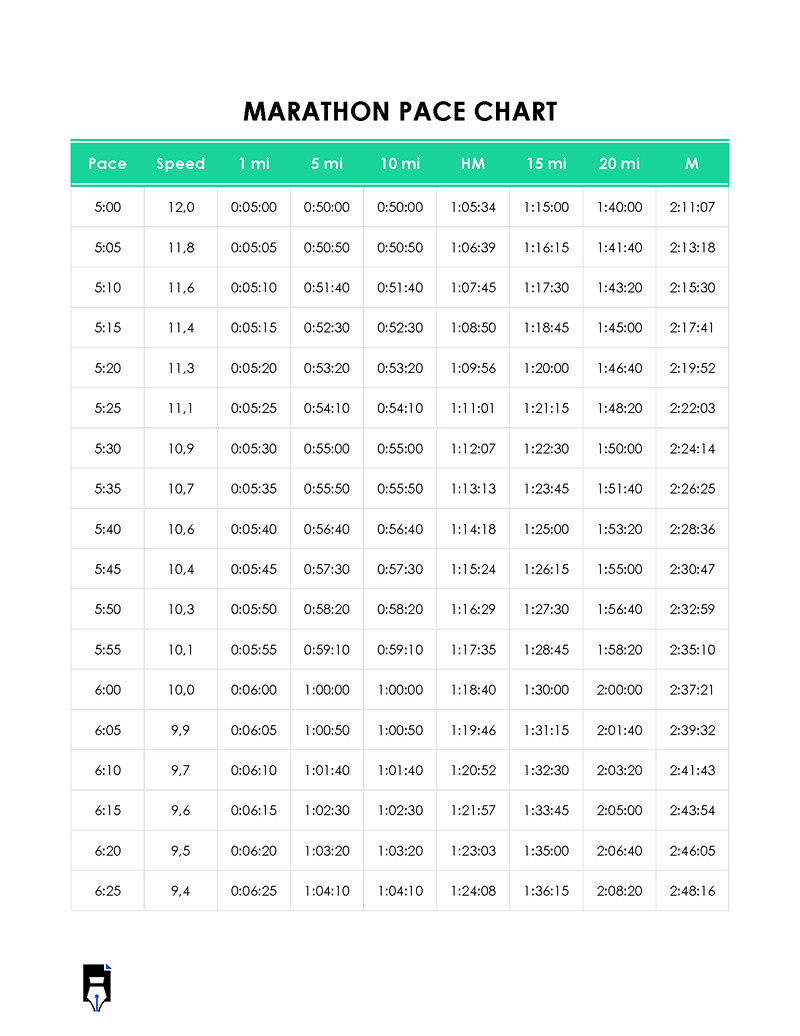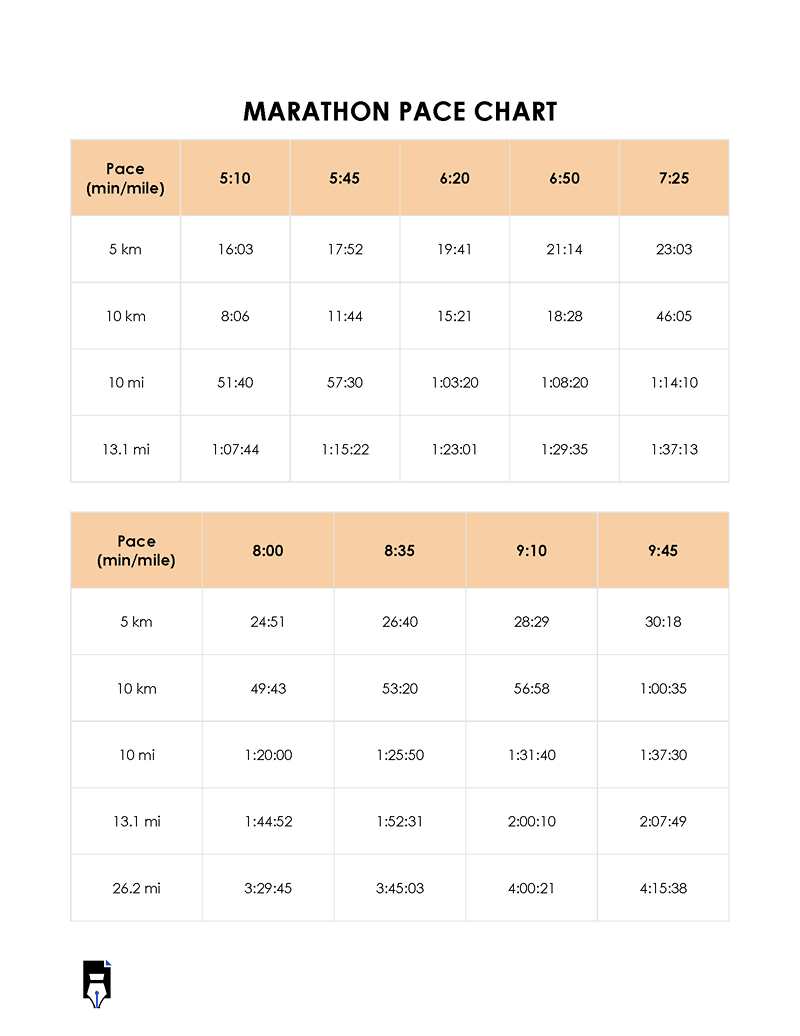A marathon is a long-distance race of 42.195 kilometers (26.219 miles/35 yards), and having a good strategy is a key contributor to the success of this race.
Given the endurance required for this activity, runners must possess physical stamina, mental strength, a strong will, and an effective strategy in order to accomplish their goals within their desired completion time. A good strategy will require runners to track and monitor their pace or speed in general throughout the race. A chart can be used to develop an appropriate and effective pacing strategy. The chart records the km/miles an individual will be running and the time in hours and minutes they intend to use. Such a chart can be used for half marathons, training, and exercise runs. It is useful for both beginner and expert runners.
This article will educate readers on the benefits of this chart, steps to take when using the visual tool, and additional details useful in planning and executing a pacing strategy.
Download Free Templates
Following are the marathon pace chart templates:
What is a Marathon Pace Chart?
Pace charts are tools used by runners to plan and track their pacing during a marathon race.
These charts provide a reference for the target time and corresponding pace per mile or kilometer for various finish time goals. By consulting a chart, runners can determine the speed they should maintain throughout the race to achieve their desired finish time. These charts often include a range of finish times, allowing runners to select a pace that aligns with their abilities and goals. This information is typically presented in minutes per mile or kilometer to help runners maintain a consistent and manageable speed throughout the race. These charts serve as valuable resources for runners to set realistic pacing goals and strategize their race performance effectively.
Some of the information that it must capture include:
- Finish Time Goals: The chart provides a range of finish time goals, such as sub-3 hours, sub-4 hours, or sub-5 hours, catering to different levels of runners.
- Pace: Pace is the speed the runner will use to cover the specific distance at the marathon. It can be given as minutes per mile or kilometers per hour.
- Total time: The total time is the entire timeframe an individual is expected to complete the marathon. The projections or goal times should be realistic. Most runners aim to complete marathons in 4 hours, but this can vary from runner to runner. This time is used to calculate the pace the runner is expected to maintain during the race.
- The chart may include split times, indicating the target time to reach a specific mile or kilometer marker along the marathon route. This helps runners monitor their progress and stay on track during the race.
- Race Strategy: Some charts offer additional race strategy tips, such as suggested starting speed, recommended pacing adjustments for uphill or downhill sections, and target negative splits (running the second half faster than the first half).
- Conversion Tables: For international marathons, such charts may include conversion tables to help runners adapt their pacing from miles to kilometers or vice versa.
- Visual Format: Pace charts are often presented in a visually appealing format, such as a table or graph, making it easy for runners to interpret and reference during the race.
If the plan is followed properly, the runner should finish the race in the targeted time. Additionally, the graph can be used to adjust the pacing strategy according to how the runner is feeling and the conditions of the day and running course. This is because several factors, such as fatigue, terrain, weather, and others, impact a runner’s speed in a way that cannot be anticipated in advance.
Tip: A runner’s pacing strategy should be based on their target or personal best (PB) time. A runner targeting to complete a marathon with a pace per mile (PM) of 3 and a half hours should maintain an average pace of 8 minutes per mile throughout the run.
Benefits of Using a Marathon Pace Chart
Using a pace chart in marathon running offers several benefits for runners. Here are some advantages to incorporating one into training and race preparation:
Pacing guidance
A pace chart provides specific target times for each mile or kilometer, based on desired finish times. It serves as a guide for runners to maintain a consistent speed throughout the race. Following the recommendations on the chart helps prevent starting too fast or too slow, enabling runners to optimize their energy and performance.
Goal setting
Pace charts assist in setting realistic goals for race performance. They help runners identify target finish times and establish mile-by-mile or kilometer-by-kilometer splits to achieve those goals. Having clear objectives enhances focus and motivation, contributing to better performance.
Strategy development
Pace charts aid in developing race strategies. They allow runners to plan for even pacing, negative splits (running the second half faster than the first), or strategic adjustments based on course elevation changes or weather conditions. Having a well-planned strategy increases the chances of achieving optimal performance.
Mental preparation
Using a pace chart instills confidence and mental preparedness in runners. It provides a sense of structure and control, reducing pre-race anxiety. Visualizing the race and being familiar with the expected speeds at each stage enhances mental focus and helps runners stay on track.
Real-time monitoring
During the race, a pace chart serves as a reference for real-time monitoring of progress. Runners can compare their actual split times with the target paces on the chart to assess their performance and make necessary adjustments. This feedback loop helps in maintaining pacing discipline and avoiding energy depletion.
Performance evaluation
After the race, these charts enable runners to evaluate their performance and analyze pacing strategies. By comparing their actual splits with the target speeds, runners can identify strengths, weaknesses, and areas for improvement in future races.
Overall, utilizing a pace chart provides structure, guidance, and motivation for runners. It assists in maintaining an optimal speed, setting goals, developing strategies, and enhancing mental preparedness, ultimately leading to improved performance in marathon running.
Steps to Using a Marathon Pace Chart
To reap the benefits of a pace chart, runners must understand how to use one to develop pacing strategies for their marathons. While it is fundamentally tabulated data on estimated race pace for different goal times, you need to use this information to create a realistic plan and make decisions about running.
Below is a procedure for utilizing the chart for your pacing needs:
Determine your target finishing time
Establish your desired time to complete the marathon. You can aim to improve on your personal best (PB). This goal should be realistic and based on your current fitness level, previous race performances, and training progress. Knowing your target time will help you choose the appropriate pace range for your race.
Identify your target time on the chart
Secondly, find your target time on the chart to determine the pace per mile or km that you should maintain to finish the race in the projected timeframe. The chart will have multiple target times to choose from for various fitness levels. For example, a beginner can select 8-10 minutes/km, an intermediate runner can select 7-8 minutes/km, and an experienced runner can select 6 or fewer minutes per km.
Determine your splits
Next, identify the timeframes within which you are to complete different segments of the marathon. Typically, the chart will have the following splits: 5k, 10k, and halfway before finishing the race. Note the speed at which you will finish each of these sections.
Adjust the strategy for course/terrain conditions
Adjust for the terrain conditions after selecting your preferred tempo. You should also consider factors such as weather conditions, changes in elevation, the nature of the terrain (smooth or rough), etc. that can affect your pace.
Monitor your pace
During the marathon, it is crucial to regularly check your current speed against the chart. This can be done using a running watch with GPS capabilities or a smartphone app that tracks your pace accurately. Continuously monitor your tempo to ensure you are maintaining the desired speed for each segment. Make periodic checks to ensure you are aware of your progress. Also, consider the splits to be your milestones. This can generate extra motivation, which you might need at some point in the race.
Adjust your pace if necessary
Lastly, adjust your pace depending on whether you are ahead or behind your pacing goals. Use the chart to determine your new pace based on the time or distance left. While adhering to the chart, it is imperative to be attentive to bodily cues and implement modifications as deemed necessary. However, it is advisable to exercise caution when effecting alterations, refraining from abrupt and extreme modifications that could precipitate feelings of exhaustion or result in physical and mental fatigue.
Did you know? Expert marathon runners use a pace of approximately 4-5 minutes per mile or faster throughout the race.
What is a Half Marathon Pace Chart?
A half marathon is an extensive race of 21.0975 km (13.1 miles). A Half-Marathon Pace Chart is a tool that provides guidance on the speed you should aim to maintain during a half-marathon race. It displays various target finishing times and the corresponding speeds for each mile or kilometer of the race.
It is the associated data table showcasing the different race paces per km/mile with corresponding finishing times for a half marathon. Runners can reference the table to identify the tempo they are expected to maintain to complete the race in their target time. The chart is divided into splits of 5k and 10k to help the runner monitor their progress throughout the race. Pace is given in minutes/km and minutes/mile, and finishing times are given in hours and minutes.
The chart helps runners establish a strategy for achieving their desired finishing time by indicating the pace at which they should be running at different stages of the race. It allows runners to track their progress and ensure they are maintaining a consistent pace throughout the entire half marathon distance
Key Takeaways
A pace chart for a marathon is a tabulated graph of different paces expressed in minutes/miles or minutes/km that runners can use to complete the race within predetermined timeframes. This tool is meant to help you develop a realistic strategy to complete the race as projected. Other than the speed, you must consider other factors, such as terrain and weather conditions, as they also affect your consistency.
Finally, it is important to recognize that a marathon is a considerably lengthy race, and it is advisable not to perceive it solely as such. Instead, it can be beneficial to conceptualize it as a series of shorter races or segments, such as 5k and 10k increments, which are managed individually. By adopting this approach, you can strategize for each shorter distance, ensuring that you conserve adequate energy for the subsequent stages of the race.
